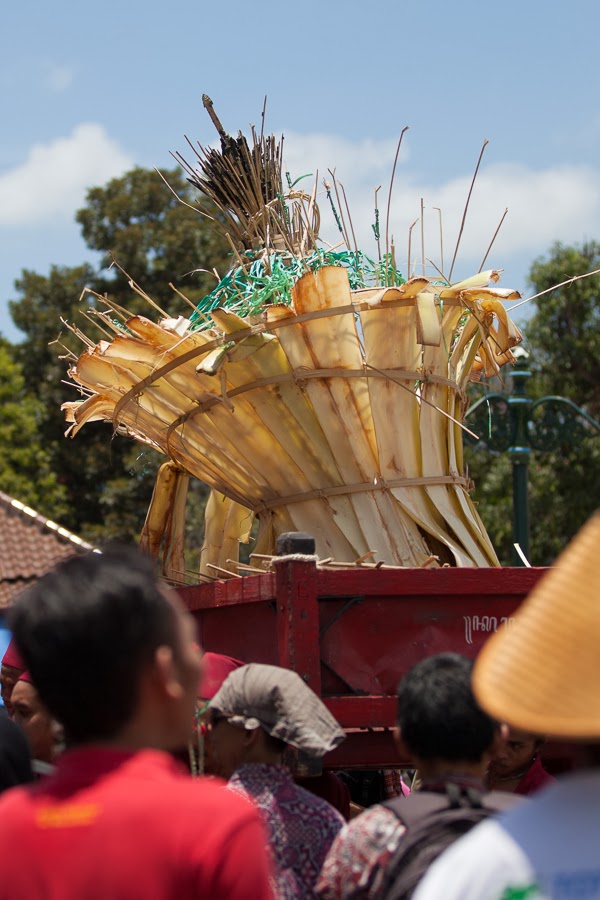Seeing the sacrifices in the courtyard of the masque for Idul Adha made me think about the sacrifices in the OT temple. I've always had this picture in my mind of the OT temple being sort of like St Paul's Cathedral in London -- big, open, clean, quiet, beautiful. I mean after all, the supplies used to build the temple were cedar, pine, bronze, and gold. Carvings and engravings of cherubim, palm trees, open flowers, lions, and wreaths decorated the walls and doors. There were even pillars with tops shaped like lilies surrounded by pomegranates. Everything was made of gold: sprinkling bowls, wick trimmers, lamps, tongs . . . everything (1 Kings 5-7). However, I think the temple was much more like the mosque I visited for Idul Adha and much less like St Paul's Cathedral.
At Idul Adha it took at least half a dozen men to hold the ropes for a single bull to be slaughtered. On the day Solomon dedicated the temple there were twenty-two thousand cattle and a hundred and twenty thousand sheep and goats sacrificed as fellowship offerings (1 Kings 8:62)! It must have taken hundreds of men slaughtering from sunrise to sunset to accomplish the offerings that day. The temple must have been a hoppin' place with all the sacrifices made on a daily basis. It must have been loud and dirty. With animal sacrifices there would have been no way to avoid the stench of blood and dung. Blood -- it must have been everywhere! In the tabernacle, the temple's precursor, blood was sprinkled on the sides of the altar, blood was sprinkled in front of the curtain, blood was put on the horns of the altar, and blood was poured out at the base of the altar (Leviticus 3-7). When Aaron and his sons were ordained they had blood put on their ear lobes, thumbs, big toes, and garments (Leviticus 8). So much for the starched white robes of holiness I imagined!
 |
| Women, in the same courtyard as slaughtering were cutting up the meat to sell or give to the needy. Really sanitary right? |
While the courtyard of the OT temple may have been messy, there was a place set apart from the chaos and the noise. This place was known as the Inner Sanctuary or Holy of Holies. There the Ark of the Covenant was kept and only the high priests entered once a year (Hebrews 9:7). I saw this idea at the mosque as well. Through a doorway from the courtyard was a place set aside for prayer, a place of cleanliness, quietness, and beauty.
A sacrifice is a chilling event to watch. What moves and cries out in one moment has no breath in the next. After visiting the mosque at Idul Adha, I can no longer read the scriptures about sacrifices the same way. A sacrifice is messy, awful, and such a high, high payment. One life given for another. Christ came to be a sacrifice, my sacrifice. Hebrews 10:10 says, "We have been made holy through the sacrifice of the body of Jesus Christ once for all." Willingly, out of love for us, Christ suffered the brutality of crucifixion. He endured a flogging so severe he medically should have been at the point of collapse or death. He was then forced to carry his own cross and was nailed to it until death. This sacrifice was horrific and bloody.
Today is Thanksgiving and I am first of all thankful for Christ's sacrifice on my behalf. The animal sacrifices were never designed to remove sin, but rather to remind us of our sin and the debt we owe (Hebrews 10:3-4). My sin, offensive to a righteous God, had payment. It was not a clean or quick payment, it was barbarous. His life for my life. His breath for my breath. His blood for my freedom. I am SO thankful. I owe him EVERYTHING! I needed this reminder today, to be once again awakened to just how great a price Christ paid for me.
Lord, help me grasp just how much you have done for me. Make the gravity of Christ's sacrifice fresh in my mind. Do not let me become accustomed to it. Do not let me take it for granted. Remind me oh Lord, that you took my place that it may spur me on to live radically for you. Amen.
Below are some pictures of more localized cultural customs being mixed in with Idul Adha:
 |
| Bare feet . . . Indonesia. |
 |
| We talked with these girls for an hour or more. |
 |
| Mountain of food, given to the poor |
 |
| Supposedly, these were baskets full of sticks that symbolized fertility or something...? |
 |
| Everyone racing to get their stick of fertility, haha, I really don't know what the sticks were for but everyone wanted one! |















.jpg)



.jpg)













